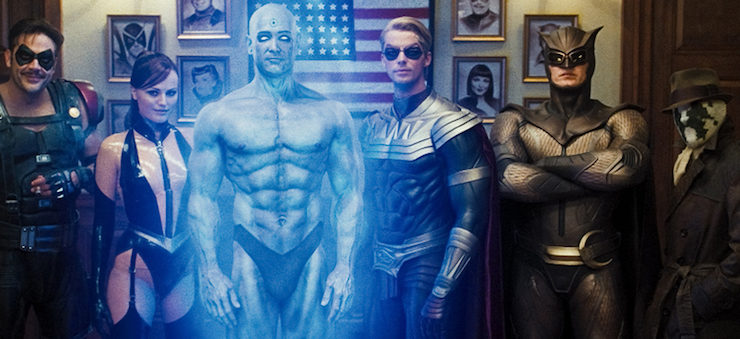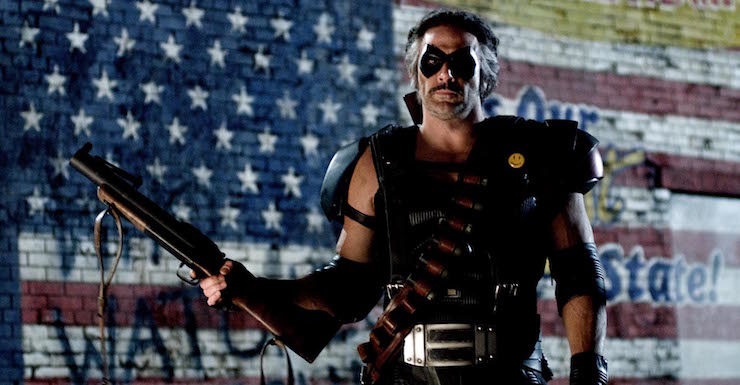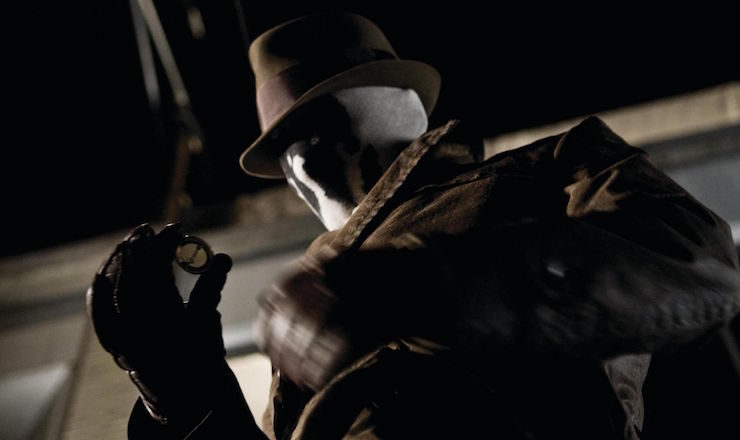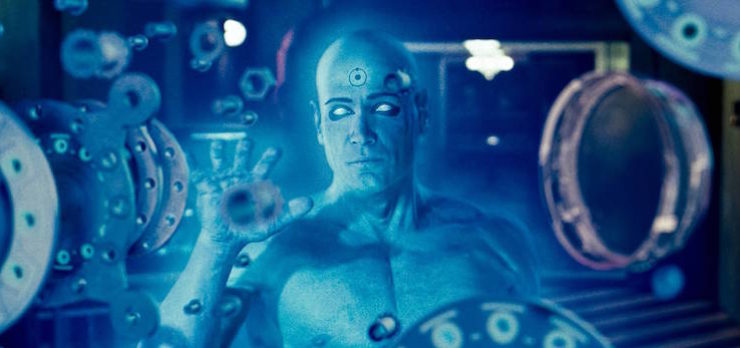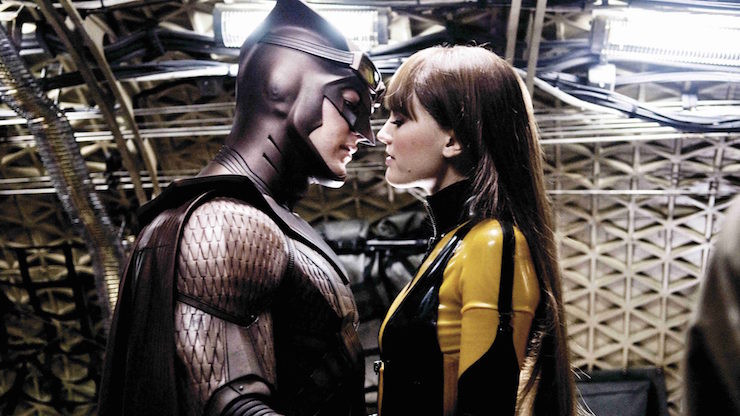Charlton Comics was never one of the heavy hitters of the comics industry, but the company had a long and respectable run as a publisher from the end of World War II until the early 1980s. They had a reputation as a “minor league” comics company, as a lot of people who became well regarded artists for Marvel and DC started out doing work for Charlton: Steve Ditko, Sal Trapani, John Byrne, Roger Stern, Denny O’Neil, Jim Aparo, Sam Grainger, Bob Layton, and Mike Zeck, among many others.
In response to both DC and Marvel reviving the superhero comic book in the late 1950s and early 1960s, Charlton created their own superhero line, including Captain Atom, Blue Beetle, the Question, the Peacemaker, Nightshade, and Peter Cannon, Thunderbolt. That line eventually petered out, and Charlton did mostly licensed comics in the 1970s.
This all relates to Watchmen, trust me.
By 1983, Charlton was in deep financial trouble. Their printing presses were old and worn out, and they didn’t have the money to do maintenance. They started running contests for new writers and artists, ostensibly to foster new talent, but truly because they didn’t have to pay them as much.
In an attempt to infuse some cash into the company, Charlton sold all their superhero characters to DC. Around the same time, Alan Moore—who was one of DC’s top writers—was looking to do something similar to what he did with Marvelman: take an old defunct superhero line and redo it in a more realistic setting. The notion was to deconstruct superheroes, in a way, to more closely yoke them to the real world and truly think through the consequences of what it would mean if people dressed up in silly outfits and fought crime.
His starting point was a murder. The initial pitch was for Archie Comics’s Mighty Crusaders, and then he adapted it to the Charlton characters when he learned that DC had bought them up. Dick Giordano, DC’s executive editor and the former managing editor at Charlton, ultimately rejected the idea, preferring that Moore create new characters.
Moore met him halfway and simply redid the existing Charlton characters. Captain Atom became Dr. Manhattan, Blue Beetle became Nite Owl, the Question became Rorschach, the Peacemaker became the Comedian, Nightshade became Silk Spectre, and Peter Cannon, Thunderbolt became Adrian Veidt, Ozymandias. Meanwhile, the originals were all incorporated into the DC Universe after 1985’s Crisis on Infinite Earths miniseries, many of them becoming major characters in the DC pantheon. (After the Watchmen trade paperback came out, Denny O’Neil and Denys Cowan did a delightful issue of The Question in which the title character reads the book and finds himself taking a shine to the Rorschach character—who was, of course, based on the Question.)
Moore collaborated with artist Dave Gibbons on Watchmen, a twelve-issue miniseries that took the world by storm. Superhero stories have always taken place in our world, just happening to have these costumed heroes and villains in it. Watchmen took a more aggressive look at what having such people in the world would actually mean to the world. In particular, if there was a superman, if there was a person who could change the course of mighty rivers, as it were, what would it do to the socio-political landscape?
As the miniseries went on, the plot almost became secondary to the examination of the history of superhero-dom through flashbacks and back matter; to the in-depth characterization, examining the psychology of a person who would dress up in a costume and beat up bad guys (or be the bad guy beaten up); and the changes to the shape of the world.
The back matter was a particularly amusing development, as originally Moore wrote up the excerpt from the original Nite Owl’s autobiography Under the Hood as something to put in the first three issues in lieu of a letters page, which would then start with the fourth issue, as the letters for #1 would have come in by then. But the Under the Hood excerpts proved so popular that Moore wound up continuing doing such pieces—an article on Dr. Manhattan, an interview with the first Silk Spectre, etc.—throughout the whole series. And they’re some of the most compelling stuff in the miniseries, in truth, adding texture to the world.
Buy the Book
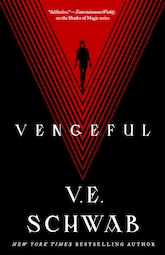

Vengeful
The film rights to Watchmen were purchased in 1988 along with Moore’s V for Vendetta, and it then went through the textbook definition of development hell. It hopped from 20th Century Fox to Warner Bros. to Universal to Revolution Studios to Paramount and back to Warner. Among the names attached to write or direct: Sam Hamm (who wrote the 1989 Batman), Terry Gilliam (who later declared the graphic novel to be “unfilmable”) and Charles McKeown, Michael Bay, Darren Aronofsky, Tim Burton, Paul Greengrass, and others. However, one constant throughout most of this was a script by David Hayter, who retained credit even on the final version that was released to theatres in 2009, though Hayter’s script had the present-day portions in an early-21st-century setting.
After going through eighty bajillion directors, Zack Snyder was approached on the strength of his adaptation of Frank Miller’s 300. Snyder had pretty much used Miller’s comic as the storyboard for the film, and he did the same for this, with Alex Tse rewriting Hayter’s screenplay. (Among other things, Tse re-set the present-day portions in 1985, leaning into the Cold War tensions that were part of everyday life when Moore wrote it.)
Snyder and his casting people did a fine job finding the right actors for the comics roles. In particular, Jackie Earle Haley, Billy Crudup, and Jeffrey Dean Morgan look like they were drawn by Dave Gibbons when they play Rorschach, Dr. Manhattan, and the Comedian, respectively. In addition, Malin Åkerman and Carla Gugino play the two Silk Spectres, Patrick Wilson and Stephen McHattie play the two Nite Owls, and Matthew Goode plays Ozymandias. Plus, the secondary roles are a veritable who’s-who of Canadian thespians: besides McHattie, there’s Matt Frewer, Jay Brazeau, Niall Matter, Robert Wisden, Chris Gauthier, Alessandro Juliani, Fulvio Cecere, Rob LaBelle, Frank Cassini, Sonya Salomaa, and Garry Chalk, among others.
Gibbons consulted on the film while Moore refused to have anything to do with it, taking neither money nor credit. He did read Hayter’s original screenplay (written in 2001) and said it was as close as anyone could come to making a Watchmen film, but that he wouldn’t be seeing it.
The graphic novel has never not been in print since its initial release in 1987 following the final issue of the miniseries, and sales and interest spiked when this movie came out in 2009, leading DC to create an entire series of “Before Watchmen” prequel comics, and later incorporating the Watchmen characters into the DC universe.
“This is all a joke”
Watchmen
Written by David Hayter and Alex Tse
Directed by Zack Snyder
Produced by Lawrence Gordon and Lloyd Levin and Deborah Snyder
Original release date: March 6, 2009
It’s 1985. Edward Blake, a.k.a. the Comedian, sits watching the news in his high-rise apartment in New York, as they discuss the possibility of the Soviet Union invading Afghanistan, including footage of President Richard Nixon, now in his fifth term, posturing.
Someone breaks into Blake’s apartment. Blake seems to have expected him, and after a brutal fight, the assailant tosses Blake out a window to his death.
The opening credits show the history of superhero-dom, starting with a bunch of people in the late 1930s becoming costumed vigilantes. The Minute Men include Nite Owl, the Comedian, Silk Spectre, Hooded Justice, Silhouette, Mothman, Dollar Bill, and Captain Metropolis. A World War II plane has Silk Spectre painted on the hull, while after V-J Day, Silhouette, rather than a sailor, kisses a woman in Times Square. Silhouette is later found murdered with her lover, “WHORE” written in blood over their bed. Dollar Bill is shot and killed when his cape is caught in a revolving door, while Mothman is institutionalized. We see Dr. Manhattan, a large blue superhero, shaking hands with President Kennedy, and then the Comedian on the grassy knoll shooting Kennedy in Dallas. Another gathering of heroes, this time with a new Nite Owl and a new Silk Spectre (the original’s daughter, Laurie), along with Ozymandias, Dr. Manhattan, and Rorschach, called the Watchmen. We see Ozymandias, a.k.a. Adrian Veidt, going into Studio 54 in New York, and also riots in the streets.
Cops investigate the Blake crime scene. Rorschach shows up later, and finds the secret closet with all his Comedian gear. Fearing that someone is targeting masked heroes, Rorschach goes to inform his remaining colleagues, starting with Dan Dreiberg, the second Nite Owl, who’s just home from his weekly beer-and-bull session with Hollis Mason, the first Nite Owl. After Rorschach tells Dreiberg about Blake, Rorschach goes to the Rockefeller Military Base to tell Dr. Manhattan and Laurie, while Dreiberg tells Veidt. As it happens, Manhattan already knew, and he teleports Rorschach away because he’s upsetting Laurie. Laurie, however, is still upset, as Manhattan is barely even noticing her anymore.
She and Dreiberg go to dinner to catch up. Afterward, Dreiberg, Manhattan, and Veidt attend Blake’s funeral, while Manhattan teleports Laurie to California to visit her mother at the retirement home. Sally Jupiter feels bad about Blake’s death, which disgusts Laurie, given that he raped her, an event we see in flashbacks. We get a series of other flashbacks through the characters at the funeral: Veidt remembers their attempt to form the Watchmen, when Blake ridicules the notion. Manhattan recalls their fighting together in Vietnam, with Manhattan’s powers allowing the U.S. to win the war handily; afterward, a woman pregnant with Blake’s baby confronts him, attacking him with a broken bottle, and Blake shoots her while Manhattan watches. Dreiberg recalls the riots in 1977 before the Keene Act was passed banning costumed heroes; Nite Owl and the Comedian tried and failed to maintain order, the latter doing so with a rifle.
After the funeral, a man with pointed ears lays flowers on the grave. This is the former villain Moloch, and Rorschach later confronts him in his home. Moloch admits that Blake visited him before he died, crying and drinking and rambling about a list and Moloch was on it, as are Jenny Slater (Manhattan’s ex-girlfriend) and others. Moloch also reveals that he’s dying of cancer.
A young man reads a pirate comic book at a newsstand while the news vendor waxes rhapsodic on various subjects. A person we’ve been seeing throughout the movie carrying a sign that reads, “THE END IS NIGH” comes by asking if this month’s New Frontiersman has come in.
Laurie and Manhattan have a fight after she realizes that (a) he’s duplicated himself so she can have sex with him twice at the same time, and (b) a third version of him is off working with Veidt on their project. She leaves in disgust, and winds up at Dreiberg’s.
Manhattan goes on TV for an interview, with various reporters in the audience asking questions. One asks about the many associates of Manhattan’s who have been diagnosed with cancer—his best friend Wally Weaver, Moloch, a few other folks, and finally his ex, Slater, who shows up with chemo hair. Reporters gang up on him, his government handlers go ballistic, and Manhattan gets fed up and teleports everyone out of the studio and himself to Mars.
Dreiberg invites Laurie to join him for his and Mason’s weekly gathering, and en route they’re mugged. However, despite being eight years out of practice, they mop the floor with the muggers. Laurie begs off continuing to Mason’s, having had enough superheroing for one night, and Dreiberg arrives at Mason’s to see the news about Manhattan going batshit.
Laurie is questioned by the government, then she escapes their custody and flees again to Dreiberg, having nowhere else to go. He shows her around his basement lair, with his old Nite Owl costume and Archie, his airship. They start to have sex on the couch, but Dreiberg finds himself unable to perform, as it were.
Manhattan creates a structure on Mars, and we also learn his origin. A physicist named Jonathan Osterman, the son of a watchmaker, he worked at Gila Flats, and started dating Slater. Osterman got stuck inside an Intrinsic Field Generator that disintegrated him. He eventually re-forms himself, albeit as a bald blue person, and demonstrates amazing powers. Weaver goes on TV and says that “God exists, and he’s American,” adding that if that fills you with existential dread, that’s okay, it just means you’re still alive and thinking. Manhattan also recalls the Watchmen meeting and being attracted to Laurie, his and Slater’s breakup, his ending the Vietnam War, and so on.
Someone makes an attempt on Veidt’s life while he’s meeting with representatives from the auto industry. He survives, but his secretary, Lee Iacocca, and several others are killed—and the assassin swallows a cyanide capsule before he can say anything.
The guy with the “END IS NIGH” sign buys this month’s New Frontiersman. The kid keeps reading the pirate comic. The news vendor is initially annoyed that he’s reading without buying, but given that Manhattan’s departure has led to the Soviets moving on Afghanistan and nuclear war seems imminent, he just gives the kid the comic.
Rorschach investigates the assault on Veidt, noting that the assassin posed as a delivery person from a company called Pyramid, which is also a company that sent Moloch pension checks. Rorschach goes to Moloch’s apartment, only to find the villain dead of a gunshot wound to the head and the police surrounding the place. After a protracted fight, the cops arrest him, and ripping his mask off, we all learn that Rorschach is the “END IS NIGH” dude. He’s brought to prison, and he tells the prison shrink how he became Rorschach. He’d already started his career as a masked vigilante, but he didn’t become Rorschach until he took on a child kidnapping case, only to discover that the kidnapper had killed the girl and fed her to his dogs. So he kills the dogs and the kidnapper.
Several prisoners are there because of Rorschach, and one tries to stab him in the chow line; Rorschach instead hits him with a tray and then pours boiling oil on him. A crime boss Rorschach put away named Big Figure informs Rorschach that as soon as that prisoner dies of his burns, the prison will erupt.
Feeling inadequate, Dreiberg stands naked in front of the Nite Owl costume. Laurie suggests they go out on patrol in Archie, and they wind up rescuing a bunch of folks from a tenement fire. That’s enough for Dreiberg to finally get it up and he and Laurie rip their costumes off and have hot monkey sex while Archie hovers over the Big Apple. Laurie even hits the flamethrower at the moment of climax, and Leonard Cohen’s “Hallelujiah” is playing on the soundtrack, just in case we weren’t sure it was a sex scene…
During their post-coital snuggle, Dreiberg says they should spring Rorschach. Laurie reluctantly agrees, and they arrive shortly after the riot Big Figure promised. Rorschach is able to dispose of Figure’s two thugs and Figure himself, then leaves with Nite Owl and Silk Spectre.
Manhattan shows up at Dreiberg’s brownstone and takes Laurie to Mars. He has no reason to care about Earth, and Laurie’s arguments fall on deaf ears. Over the course of their talk, she realizes that Blake was, in fact, her father, that Sally slept with Blake a second time after the rape and that was when Laurie was conceived. Manhattan realizes that the random amazingness of life is pretty awesome and accompanies Laurie back to Earth.
Mason sees the news story on Rorschach’s breakout, and calls Sally, and the pair reminisce. Some thugs find out that Nite Owl freed Rorschach, and think it’s Mason who did it, so they go to his house and beat the crap out of him, killing him.
Rorschach found a matchbox in the apartment of Veidt’s killer, and they go to the bar on that matchbox, only to find out that someone there is also employed by Pyramid—hired by Slater. They go to Veidt’s office to consult with him, but there’s no sign of him. However, they find evidence that Veidt owns Pyramid—he’s the mask killer. (He hired the person who killed his secretary and Iacocca to deflect Rorschach’s inquiries.)
They also discover that he’s at his Antarctic base. After stopping to drop Rorschach’s journal off at the New Frontiersman offices, they fly Archie to Antarctica, where Veidt has killed the other scientists working on the project he and Manhattan were collaborating on to create a new energy source. Nite Owl and Rorschach arrive and they try to fight Veidt, but Veidt makes a fool out of them both, then reveals his plan: to destroy sections of several large cities and make it look like Manhattan did it. The world’s super-powers will unite in fear of more retribution from the superman.
Manhattan arrives to stop him, but Veidt uses an intrinsic field generator to disintegrate him. Manhattan is able to pull himself together—that was the first trick he learned, after all—but by that time, the cities have been attacked, thousands have died (including the news vendor and the kid reading the comic, who were in Times Square when Vedit’s weapon hit), and the world’s powers have, indeed, come together. Laurie, Manhattan, and Dreiberg agree to keep Veidt’s secret for the sake of this new peace. Rorschach refuses, and Manhattan is forced to kill him.
Dreiberg and Laurie think about restarting their masked adventurer careers. Manhattan buggers off to another galaxy. Veidt thinks he’s won. Meanwhile, the New Frontiersman needs a front-page story, and the intern finds this journal in the crank file…
“The end is nigh”
In a lot of ways, Zack Snyder made the best Watchmen film possible. But the real problem is in making Watchmen into a movie in the first place, which is a dangerous and difficult proposition. And it’s not because the movie is “unfilmable” as Terry Gilliam declared, because it is filmable. It’s just what you wind up filming that’s the problem.
When you adapt a longer work into a shorter work—like, for example, adapting a 300-page novel into a 100-page screenplay, or a twelve-issue comics miniseries into a three-hour movie—you have to, in essence, boil it down. You get rid of the subplots, the extras, the grace notes, the character bits, and focus on the main plot. You excise Tom Bombadil from the story, you get rid of the flashbacks detailing Domingo Montoya’s life, you combine Dubois and Rasczak into a single character, and so on.
Here’s the thing: the reason why Watchmen is so appealing is because of the subplots, the extras, the grace notes, the character bits. The actual plot is, bluntly, dumber than a box of hair. You can forgive that in the comic book because it’s been such a great ride up until then. Well, mostly. I still remember the “wait, what?????” moment I had reading the graphic novel in college when I got to the part where Ozymandias fakes an alien invasion to bring the nations of the world together. But I was captivated by the world building and the characters, so I forgave the dumbshit climax.
Harder to do that in a movie. Snyder tries his best, but in truth the ideal format for a Watchmen adaptation is to go along with the structure of the comic: a twelve-part TV miniseries.
But that’s not what we got. Instead we got this mess.
This movie winds up telling its story in four distinct sections that don’t really cohere as well as Snyder wants them to. We start out with a section that’s all about the Comedian, as we slowly learn more and more about this guy who’s been killed. But once we dispense with the flashbacks, it becomes about Dr. Manhattan, with Blake seemingly forgotten, and the focus is on how Manhattan is led to leaving Earth, culminating in a lengthy sequence that shows Manhattan’s origin. Then we cut back to Rorschach, and it’s rather a shock, as we haven’t seen Rorschach in a while and we’ve kind of forgotten about him, but he’s captured, and then we focus a lot on his travails in jail until Nite Owl and Silk Spectre break him out. Then we have the climax.
The biggest change in the plot is that Veidt’s plan is to frame Manhattan for the destruction that brings the world together instead of creating an alien monster who teleports into New York and kills a ton of people. The thing is, while that’s a bit better than the comics’ version (which was just goofy), it’s basically the same idea: a fictional, but destructive, threat brings the world together. But it’s a temporary fix in either case, one that won’t result in a lasting peace, especially since neither the alien monsters nor Dr. Manhattan are ever going to follow up.
And the movie suffers from Veidt’s plan being so much of the focus, because it’s still really dumb. We’ve gotten three character studies up until then, and they all fail on one level or another.
The Comedian section actually works well, mainly because Jeffrey Dean Morgan so perfectly nails it, but then Blake really has nothing to do with the rest of the movie. The revelation that Laurie is his daughter doesn’t land at all, nor do the “joke” references made by Dreiberg made at the end, because after being the focus for the first section, Blake’s been no kind of presence in the movie for way too long. (In addition, the whole part of the plot involving Sally going back to sleep with Blake after he assaulted and raped her has aged really badly—more so the comics version, in which Laurie talks at the end like she’s going to be more like Blake in her superhero identity, which is revolting.)
Arguably the two best issues of the original comic book are the fourth and sixth. The former tells Manhattan’s entire story, in a rather non-linear manner akin to how Manhattan perceives time, the latter Rorschach’s. The movie tries its best to re-create these issues, but fails. Manhattan’s backstory grinds the movie to a halt, but doesn’t really do his story justice (and is a bit too linear, sadly).
And Rorschach’s story is completely botched. I always found one of the two or three most interesting characters in Watchmen to be Rorschach’s shrink, Dr. Malcolm Long. Watching him change as he gets to know Rorschach is one of the most compelling parts of the comic. But we don’t get that here—Long is reduced to a quick walk-on, and we only get the last part of Rorschach’s story, which is robbed of its buildup.
In both the cases of Manhattan and Rorschach, Snyder tries his best to include as much of these two strong issues of the original as possible, but in both cases, the pacing suffers for it. When you’re reading even the collected version of Watchmen, it’s in twelve discreet portions, each separated by the bit of back matter, so the pacing is set by the format. But a movie is a single discreet portion, and these moments need to be shortened so much in order to squeeze into the time that they don’t work as well as intended and come across as distractions to the plot.
(These pacing issues are exacerbated by the “Ultimate Cut” which incorporates the animated version of the Tales of the Black Freighter comic book that the kid reads at the newsstand. Those were among the worst parts of the comic book, and the parts I always skip over when I re-read it. It’s a nice exercise in nostalgia, but it just distracts from the storyline in both comic and movie. It honestly works best as a DVD extra—Gerard Butler does a fine job as the voice of the protagonist.)
And, again, the plot is really really dumb. I can’t emphasize that enough. On top of everything else, changing the alien monster to a simple frame-up of Dr. Manhattan makes Blake’s existential angst about the project when he learns about it and bares his soul to Moloch ridiculous. The new version of the plot doesn’t really track with Blake losing it that much.
It’s too bad because the movie does do some parts quite right. The look and feel of the 1980s, even a changed one, is nicely done, ditto the flashbacks to earlier times that are very well re-created. In general, the movie is a visual feast, with some very striking scenes, from the Vietnam flashbacks to Manhattan’s flying glass structure on Mars to the prison riot.
And many of the casting choices are letter perfect. In particular the three people who are the focus of the first three sections—Morgan as the Comedian, Billy Crudup as Manhattan, and Jackie Earle Haley as Rorschach—are simply magnificent. Crudup nails the calm remove of Manhattan, Morgan (seemingly auditioning for Negan here) embodies the Comedian’s sleazy machismo to a T, and Haley is almost frighteningly spot-on as Rorschach. Props also to Carla Gugino and Stephen McHattie as the older versions of Silk Spectre and Nite Owl, though being slathered in old-age makeup doesn’t do Gugino any favors. I particularly liked Mason’s final fight, as each punk he punches flashes onto a villain from his hero days—it’s a nice little tribute to this world’s first masked hero. (I also must confess to being pleased that they didn’t go to all the contortions the comic did to avoid full-frontal nudity on Manhattan, who by 1985 has given up clothes as a ridiculous contrivance. They let Manhattan’s big blue penis just hang out there for all to see. In a medium where female nudity is perfectly fine but male nudity is often viewed as yucky, this is heartening to see.)
Sadly, not all the other casting choices work so well. Patrick Wilson is perfectly adequate as Dreiberg, but he never really conveys any kind of depth. Malin Åkerman has even less depth as Laurie, managing only the character’s frustrations but not her sadness or tragedy or strength. And Matthew Goode falls completely flat as Veidt—though, to be fair, one of the flaws of the original is that Veidt simply is too bland and uninteresting as a character. Goode does nothing to fix that, and in fact makes it worse by making him a lisping effete, leaning into Rorschach’s one-line description of him in the comics as being possibly homosexual. Given that Rorschach is the textbook definition of an unreliable narrator, focusing on that seems ill-advised, and succumbing to the stereotype of the gay guy being evil is just tired. (One of the folders on Veidt’s password protected Mac—another nicely retro re-creation—is labelled “Boys.”)
Also Snyder makes one filmmaking choice that undercuts the point of the story, which is the stylized and brutal fight scenes. I’m actually okay with the brutality—all too often, violence on screen is virtually consequence-free, so I’m fine with actual broken bones and blood and such. What I have a problem with is Dreiberg and Laurie being so incredibly good at hand-to-hand combat even after being inactive for eight years. What I have a problem with is all these normal people doing superhuman things, from Rorschach’s jump up to Moloch’s fire escape to the punishment that Nite Owl and Rorschach take at Veidt’s hands to Veidt’s fight with the Comedian, which has both of them showing strength no normal person would have. The whole point of Watchmen was to insert masked adventurers into the real world and see what happens, but making the fights so stylized and over-the-top messes that up.
I enjoy watching this movie for Morgan’s and Crudup’s and especially Haley’s performances, but it’s ultimately a failed adaptation of a great work, because the very process of adapting it into a shorter form can’t help but expose the great work’s one major flaw for all to see. It’s a noble failure, but it’s still a failure.
(This movie was also the last time I’d think well of Snyder as a director. But we’ll talk more about that when we get to Man of Steel later in this rewatch.)
For the next three weeks, we’ll be back with the X-Men franchise, specifically the three movies focusing on its breakout star, Hugh Jackman as Wolverine. Next week, X-Men Origins: Wolverine.
Keith R.A. DeCandido recently won the Scribe Award, given by the International Association of Media Tie-in Writers, for Best Short Story for his tale “Ganbatte” in Joe Ledger: Unstoppable, a Lydia “Warbride” Ruiz story about martial arts, the Florida Keys, and sexual harassment.










